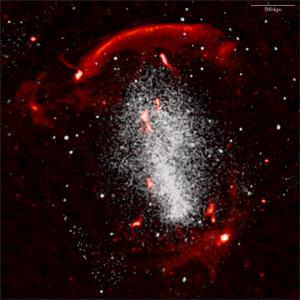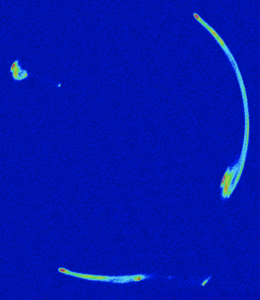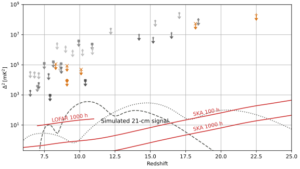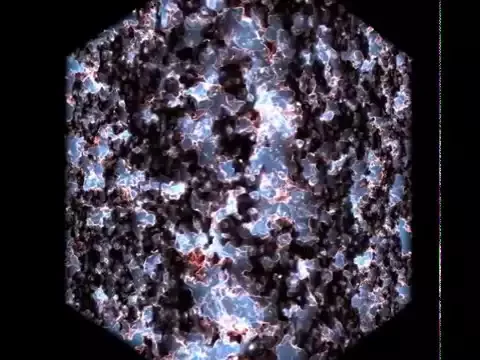GALAXY CLUSTERS
People involved: Tim Shimwell
As the Universe evolves, gravity brings together hundreds, sometimes thousands of galaxies to form the largest gravitationally bound objects in the Universe, galaxy clusters. During this formation, energy is dissipated via gigantic shock waves and turbulence over regions spanning millions of light years. These processes result in the acceleration of particles to relativistic speeds, which in the weak galaxy cluster magnetic fields, causes the emission of synchrotron radiation. This radiation can be observed with radio telescopes and examining it allows us to probe the formation and evolution of galaxy clusters including their magnetic fields, the tenuous plasma that pervades the clusters, the physics of particle acceleration and even the individual galaxies and their interaction with the local environment.
At ASTRON, we have using cutting edge telescope such as LOFAR to detect and study many spectacular clusters with particle acceleration occurring over regions spanning millions of light years in both the distant and more local Universe. Examples include the prototypical shock waves seen in the so-called sausage cluster (image below) through to complex cases like that seen in the cluster Abell 1314 (image below).


GRAVITATIONAL LENSING AND TESTS OF DARK MATTER
People involved: John McKean
The hierarchical model for galaxy formation requires massive galaxies, like our own Milky Way, to form through the mergers of many lower-mass galaxies. Under this scenario, we expect that many of these lower-mass galaxies should survive the merger process, and remain as compact clumps of matter within the more massive galaxies. The predicted abundance and clumpiness of these lower mass galaxies is highly dependent on the model that we assume for dark matter. As they are thought to be primarily made of dark matter, we can only detect them in distant galaxies, or throughout the Universe, via their gravitational lensing effect.
At ASTRON, we are using extremely high angular-resolution imaging with very long baseline interferometry to determine the abundance of these low mass galaxies in the Universe. We do so by precisely identifying the small angular deflections of light that they cause in lensed images (example below) and testing these against predictions from various dark matter and galaxy formation models.

COSMIC DAWN & EPOCH OF REIONIZATION
People involved: Andre Offringa, Harish Vedantham
After emitting the cosmic microwave background radiation, about 400,000 years after the big band, the Universe cooled to a dark sea of pristine hydrogen gas. This era is called the dark ages due to the absence of stars and lasted for almost 200 million years. The relentless action of gravity during the dark ages slowly brought together the gas into denser pockets and eventually led to the birth of the first stars and galaxies in an era called the Cosmic dawn. Hot radiation produced by the first stars and their remnants ionised and heated up the unused hydrogen gas throughout the Universe in an era called the Epoch of Reionization. The dark ages, cosmic dawn and epoch of Reionization are among the last unexplored events in the history of the Universe and re captured in the simulation shown below.
Hydrogen gas preferentially interacts with radio waves with a frequency of about 1420 MHz or wavelength of about 21-cm. These waves are 'redshifted' into the LOFAR telescopes frequency band by the time they reach the Earth having travelled from the early Universe. ASTRON scientists are part of an international collaboration that aims to detect this 21-cm signal from the early Universe for the first time. Such a detection will paint a detailed picture of the last unexplored epoch in the history of your Universe and help us understand the properties of the first stars and galaxies that formed in the Universe and the effect they had on the hydrogen gas that permeates the Universe.
Directly making an image of the neutral hydrogen gas as seen in the simulation above requires unprecedented sensitivity and will have to await the completion of the Square Kilometre Array telescope's constructions. However LOFAR has the necessary sensitivity to statistically detect the presence of spatial fluctuations in the presence and temperature of hydrogen gas. Achieving this still requires and exquisite understanding of the telescope and the various factors that can corrupt the radio signals such as the Earth's atmosphere. At ASTRON, we are involved in all aspects of data acquisition and processing and we have published competitive limits on the strength of the cosmic 21-cm signal. For example, the figure below shows out latest limits.

